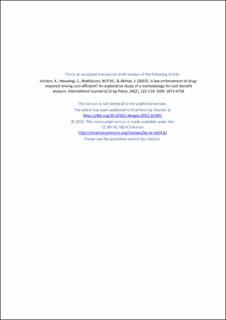| dc.contributor.author | Veisten, Knut | |
| dc.contributor.author | Houwing, Sjoerd | |
| dc.contributor.author | Mathijssen, M.P.M. | |
| dc.contributor.author | Akhtar, Juned | |
| dc.date.accessioned | 2021-07-18T15:53:49Z | |
| dc.date.available | 2021-07-18T15:53:49Z | |
| dc.date.created | 2013-06-18T12:10:13Z | |
| dc.date.issued | 2012-11-02 | |
| dc.identifier.citation | International journal of drug policy. 2013, 24 (2), 122-134. | en_US |
| dc.identifier.issn | 0955-3959 | |
| dc.identifier.uri | https://hdl.handle.net/11250/2764732 | |
| dc.description.abstract | Background Road users driving under the influence of psychoactive substances may be at much higher relative risk (RR) in road traffic than the average driver. Legislation banning blood alcohol concentrations above certain threshold levels combined with roadside breath-testing of alcohol have been in lieu for decades in many countries, but new legislation and testing of drivers for drug use have recently been implemented in some countries. Methods In this article we present a methodology for cost–benefit analysis (CBA) of increased law enforcement of roadside drug screening. This is an analysis of the profitability for society, where costs of control are weighed against the reduction in injuries expected from fewer drugged drivers on the roads. We specify assumptions regarding costs and the effect of the specificity of the drug screening device, and quantify a deterrence effect related to sensitivity of the device yielding the benefit estimates. Results Three European countries with different current enforcement levels were studied, yielding benefit–cost ratios in the approximate range of 0.5–5 for a tripling of current levels of enforcement, with costs of about 4000 EUR per convicted and in the range of 1.5 and 13 million EUR per prevented fatality. Conclusions The applied methodology for CBA has involved a simplistic behavioural response to enforcement increase and control efficiency. Although this methodology should be developed further, it is clearly indicated that the cost-efficiency of increased law enforcement of drug driving offences is dependent on the baseline situation of drug-use in traffic and on the current level of enforcement, as well as the RR and prevalence of drugs in road traffic. | en_US |
| dc.language.iso | eng | en_US |
| dc.publisher | Elsevier | en_US |
| dc.rights | Attribution-NonCommercial-NoDerivatives 4.0 Internasjonal | * |
| dc.rights.uri | http://creativecommons.org/licenses/by-nc-nd/4.0/deed.no | * |
| dc.title | Is law enforcement of drug-impaired driving cost-efficient? An explorative study of a methodology for cost-benefit analysis | en_US |
| dc.type | Peer reviewed | en_US |
| dc.type | Journal article | en_US |
| dc.rights.holder | © 2012 Elsevier B.V. All rights reserved. | en_US |
| dc.description.version | acceptedVersion | en_US |
| cristin.ispublished | true | |
| cristin.fulltext | postprint | |
| cristin.qualitycode | 1 | |
| dc.identifier.doi | 10.1016/j.drugpo.2012.10.001 | |
| dc.identifier.cristin | 1034928 | |
| dc.source.journal | International journal of drug policy | en_US |
| dc.source.volume | 24 | en_US |
| dc.source.issue | 2 | en_US |
| dc.source.pagenumber | 122-134 | en_US |

